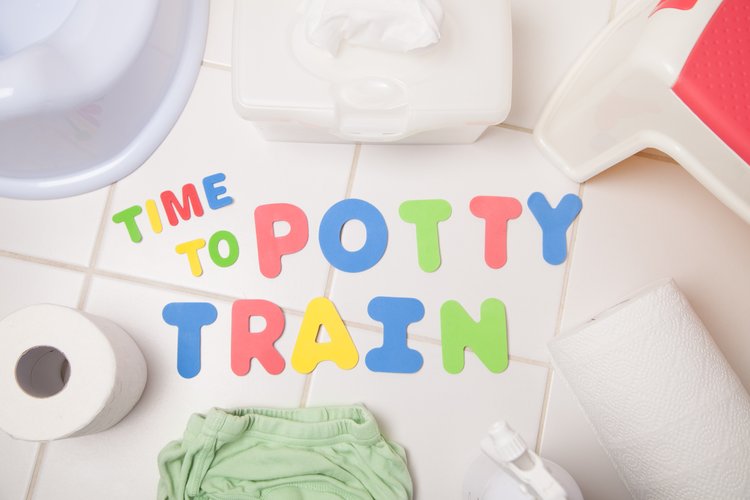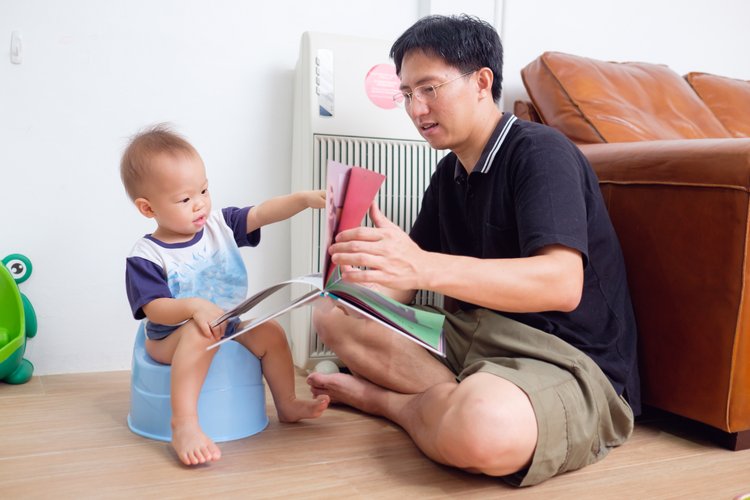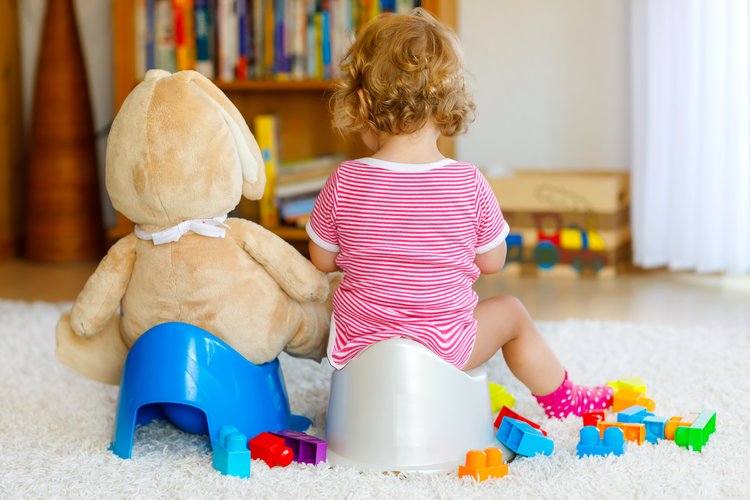Potty Training Time Tips for Making Potty Training Easy

The thought of potty training can simultaneously strike joy and fear in a mom’s heart. The idea of getting rid of diapers is exciting, but the thought of potty training can be daunting. Potty training can be tough, and it can certainly test your patience. But you’ve got this! After all, how many school-age kids do you know who are still in diapers?
Many experts agree that you can’t rush potty training. Make sure you start the process when your child is ready, not when you are ready. And if you have a big change coming, such as the arrival of a new baby or a move, it may be worth waiting to start the training process until your child has had time to adjust to the changes. Above all, you need patience and consistency to get the job done.
We’ve compiled some tips to make the training process easier for both you and your toddler. However, as with any milestone in your baby’s development, be sure to talk to your pediatrician. He or she can help you recognize when your toddler is ready to start the process of potty training, discuss strategies most likely to be beneficial for your child, and help you know when to take a break or how to handle setbacks as they occur. And, when you’re ready to start, it can be helpful to set aside a weekend or a few days when you can be at home to focus on training.
Signs Your Child May be Ready to Potty Train
There’s no set age to begin potty training. Just like eating solid foods, talking, and walking, children develop readiness to potty train at different times. Many children show signs of being ready to train between 18 and 24 months; other children may not be ready until they’re 3 years old. If you try to train a child who is not ready, it can cause frustration for you and your child – and delay the process. If you’re concerned that your child is not ready and you think he should be, or if your child is going to a pre-school that requires that he is potty trained by a certain age and you’re not having any luck, be sure to talk to your child’s pediatrician. Otherwise, when your child is exhibiting these signs, she may be ready for the big girl potty:
· She can walk (so she can get herself to the potty)
· He can talk and understand basic directions (so he can tell you when he needs to go)
· He can pull his pants down and back up
· She notices when her diaper is wet or dirty and doesn’t like it
· She can stay dry for 2 hours
· He is interested in using the toilet or in wearing “big boy underwear”
· She can sit on a potty long enough to go
What You Need to Begin Potty Training
Start to talk to your child about using the “big boy potty.” Help him understand what will happen and avoid using words like “stinky” or “dirty;” after all, going to the bathroom is a natural part of life. Books can help prepare your child and teach her vocabulary related to potty training. Make sure you get some gear to make it easier for your child to use a potty. Consider some of these options:
· A child potty that you can place in the bathroom: It’s easier for a child to sit on a small potty than to climb up to a toilet. Using a child potty also makes it easier for a child to keep his feet on the ground when sitting, making it easier for him to go.
· A child seat for a regular toilet and a step stool: If you don’t want the hassle of cleaning a child potty, you may opt to put a smaller seat on a regular toilet seat. Make sure you have a safe step stool your child can use to climb up to the seat. And your child should be able to rest her feet comfortably on the step stool when she’s sitting. This will make it easier for her to potty.
· Clothing that’s easy to remove: opt for clothing that is easy for your child to get off when it’s time to potty. You may want to switch from diapers to a pull-up type diaper. Pull-ups are easier for your child to get down and up, and, since pull-ups are closer to “big girl underwear,” wearing these may encourage her to use the potty so she doesn’t have to go back to diapers.
How to Know if Your Child Needs to Go
Children have a hard time covering it up when they “have to go.” Although at first, he may not be able to tell you when he needs to go, watching his behavior can give you an indication of when it’s time. He may make what some refer to as the “potty face,” where he might scrunch his nose or have a look of intense concentration. Or he might squirm around, suddenly stop walking, or pause what he’s doing even if he’s in the middle of playing. Some kids will even try to hide when they need to go! If you pay attention, you’ll figure out when he needs to go. Watch him closely so you see the signs.

How to Encourage Your Child to Go
A lot of kids get stage fright when it comes to the potty. She can go in her diaper all day long, but, as soon as you as she gets on the toilet, she freezes up. Remember, using a potty is brand new for your toddler and takes getting used to. Stay calm, and don’t make a big deal if she can’t go in the moment. If she sees that you’re frustrated, it can make her nervous to try again.
When you see she needs to go, encourage her to use her potty. Even if she can’t at the moment, you’ll help her associate the need to go with getting to the potty on time. Your child may need help getting comfortable. Explain how to sit to make it easier to go. (And if your son stands, explain how to aim!)
Take this time to start talking to your child about hygiene as well. Teach her how to wipe to avoid potential infections. Help him wash his hands after every trip to the potty. Even when your child is potty trained, it may still take a bit longer for him or her to be able to wipe correctly after a bowel movement. But you can still teach the basics – including how much paper to use.
How to Reward Your Child
Bribing your child can be a hit or miss, but in the case of potty training, it’s often a hit. It’s usually not a healthy practice to bribe your children to do what you want—she needs to learn to do what she is asked without the promise of a reward; however, going to the bathroom isn’t a matter of obeying. Some children might need a little more encouragement to go when and where she’s they’re supposed to.
That’s where rewards come into play.
When she goes potty correctly, offer her something small that you know she will like. It can be a small toy, sticker, or a treat, but keep it small just something that will get her excited enough to want to potty.
Another option is to help her keep track of when she goes potty by making a colorful chart. Try drawing a circle on paper, then draw lines to the center like a pie chart. Every time she uses the potty correctly, color in a piece of the pie. Tell her, “When you’ve colored the whole pie, you get a prize.” Some parents use “big kid underwear” as a prize or incentive to use the potty.
Sometimes, a little nudge in the right direction goes a long way and making a game out of potty training can help encourage your little one along.
Praise Your Child
Remember that using a potty is a strange and new phenomenon for a child. He loves to see that you’re excited when he goes the right way. Kids catch on quickly to what makes mommy happy, so if you praise him and help him to see that you’re proud of him, he will be more likely to continue.
Brag on him when he goes!

Practice Makes Perfect
Potty training can be difficult to manage, but, like most things in life, practice makes perfect. It will take a few days, a few weeks, or even a few months for some kids to master the idea process of going to the bathroom correctly, but the more you practice with her, the easier she will learn. Consistency is key.
It takes a lot of patience to potty train a child. And remember, mistakes will happen. Be prepared. If you need to leave home or take your child to a sitter or daycare while training, be sure to bring along extra clothes for her to change into if she has an accident. And roll with it – don’t get upset when accidents happen. You don’t want your child to feel ashamed when he’s learning.
If your child is having a hard time getting the hang of potty training, it may be a sign to stop for now and try again in a few months. It could be that she’s just not quite ready yet. There’s nothing wrong with taking a break and trying again at another time.
And sometime setbacks happen. A change in schedule can affect your child. Or sometimes she doesn’t want to stop what she’s doing to go potty. Setting a schedule can be helpful in these cases. However, talk with your child’s pediatrician about any issues, especially if you suspect there may be a physical cause to the set-back.
Also remember that it takes a child longer to learn to sleep through the night without an accident, so, even if he’s not having an accident during the day, he may still need pull-ups or a protective mattress cover for a while longer at night.
Any change is a big change for a child, but kids are adaptable. She’ll get there! In the meantime, just enjoy bonding with your child as she takes this next step and have fun with it!
Connect With Us
Having the right community around you is so important as a mother. One by One Ministries is dedicated to helping women and mothers connect. We offer practical motherhood advice and provide mentorships programs for women looking for guidance on motherhood.
If you’re interested in finding out more about us, click here or contact us to get involved!
